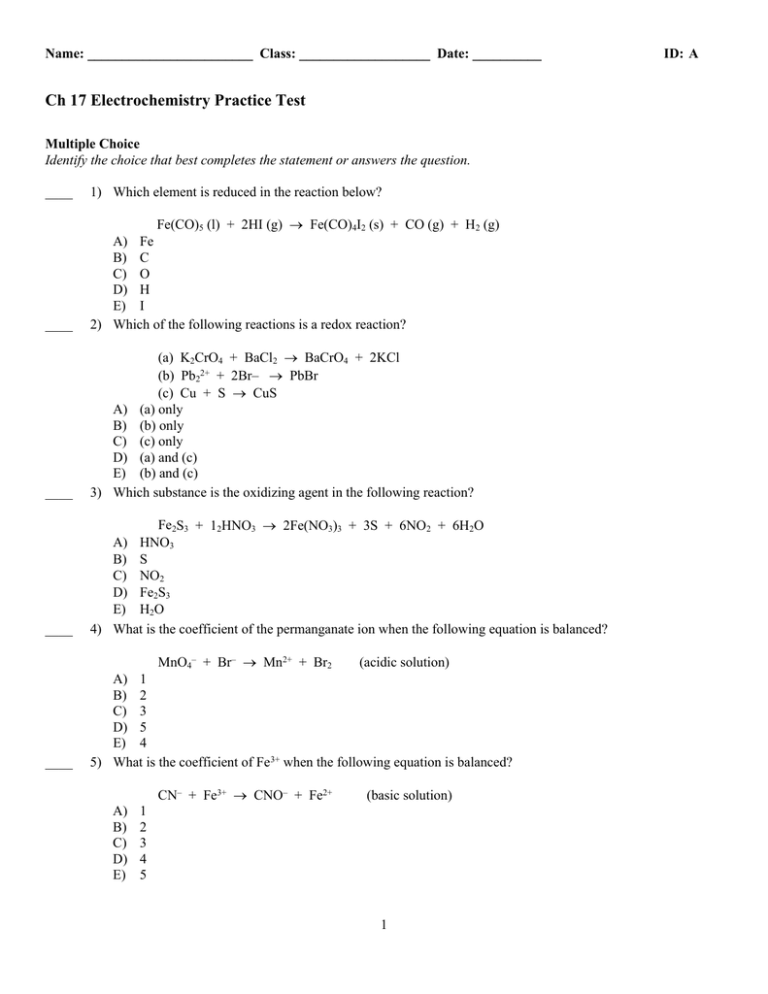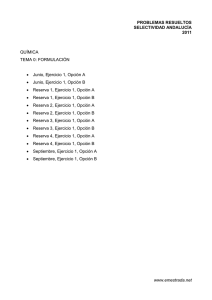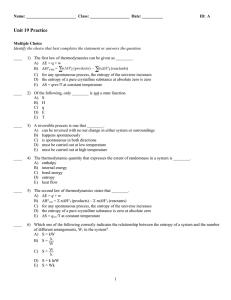Electrochem PT
Anuncio

Name: ________________________ Class: ___________________ Date: __________ Ch 17 Electrochemistry Practice Test Multiple Choice Identify the choice that best completes the statement or answers the question. ____ 1) Which element is reduced in the reaction below? Fe(CO)5 (l) + 2HI (g) Fe(CO)4I2 (s) + CO (g) + H2 (g) ____ A) Fe B) C C) O D) H E) I 2) Which of the following reactions is a redox reaction? ____ (a) K2CrO4 + BaCl2 BaCrO4 + 2KCl (b) Pb22+ + 2Br– PbBr (c) Cu + S CuS A) (a) only B) (b) only C) (c) only D) (a) and (c) E) (b) and (c) 3) Which substance is the oxidizing agent in the following reaction? ____ Fe2S3 + 12HNO3 2Fe(NO3)3 + 3S + 6NO2 + 6H2O A) HNO3 B) S C) NO2 D) Fe2S3 E) H2O 4) What is the coefficient of the permanganate ion when the following equation is balanced? MnO4– + Br– Mn2+ + Br2 ____ (acidic solution) A) 1 B) 2 C) 3 D) 5 E) 4 5) What is the coefficient of Fe3+ when the following equation is balanced? CN– + Fe3+ CNO– + Fe2+ A) B) C) D) E) (basic solution) 1 2 3 4 5 1 ID: A Name: ________________________ ____ ____ ____ ID: A 6) Which transformation could take place at the anode of an electrochemical cell? A) Cr2O72– Cr2+ B) F2 to F– C) O2 to H2O D) HAsO2 to As E) None of the above could take place at the anode. 7) The purpose of the salt bridge in an electrochemical cell is to ________. A) maintain electrical neutrality in the half-cells via migration of ions B) provide a source of ions to react at the anode and cathode C) provide oxygen to facilitate oxidation at the anode D) provide a means for electrons to travel from the anode to the cathode E) provide a means for electrons to travel from the cathode to the anode 8) Which transformation could take place at the cathode of an electrochemical cell? A) MnO2 MnO4– B) Br2 BrO3– C) NO HNO2 D) HSO4– H2SO3 E) Mn2+ MnO4– Table 20.1 Half Reaction F2 (g) + 2e– 2F– (aq) Cl2 (g) + 2e– 2Cl– (aq) Br2 (l) + 2e– 2Br– (aq) O2 (g) + 4H+ (aq) + 4e– 2H2O (l) Ag+ + e– Ag (s) Fe3+ (aq) + e– Fe2+ (aq) I2 (s) + 2e– 2I– (aq) Cu2+ + 2e– Cu (s) 2H+ + 2e– H2 (g) Pb2+ + 2e– Pb (s) Ni2+ + 2e– Ni (s) Li+ + e– Li (s) E°(V) +2.87 +1.359 +1.065 +1.23 +0.799 +0.771 +0.536 +0.34 0 –0.126 –0.28 –3.05 ____ 9) Which of the halogens in Table 20.1 is the strongest oxidizing agent? A) Cl2 B) Br2 C) F2 D) I2 E) All of the halogens have equal strength as oxidizing agents. ____ 10) Which one of the following types of elements is most likely to be a good oxidizing agent? A) alkali metals B) lanthanides C) alkaline earth elements D) transition elements E) halogens 2 Name: ________________________ ID: A ____ 11) Consider an electrochemical cell based on the reaction: 2H+ (aq) + Sn (s) Sn2+ (aq) + H2 (g) ____ 12) ____ 13) ____ 14) ____ 15) ____ 16) ____ 17) Which of the following actions would change the measured cell potential? A) increasing the pH in the cathode compartment B) lowering the pH in the cathode compartment C) increasing the [Sn2+] in the anode compartment D) increasing the pressure of hydrogen gas in the cathode compartment E) Any of the above will change the measure cell potential. What is the anode in an alkaline battery? A) MnO2 B) KOH C) Zn powder D) Mn2O3 E) Pt What is the cathode in an alkaline battery? A) MnO2 B) KOH C) Zn powder D) Mn2O3 E) Pt In a lead-acid battery, the electrodes are consumed. In this battery, ________. A) the anode is Pb B) the anode is PbSO4 C) the anode is PbO2 D) the cathode is PbSO4 E) the cathode is Pb Cathodic protection of a metal pipe against corrosion usually entails ________. A) attaching an active metal to make the pipe the anode in an electrochemical cell B) coating the pipe with another metal whose standard reduction potential is less negative than that of the pipe C) attaching an active metal to make the pipe the cathode in an electrochemical cell D) attaching a dry cell to reduce any metal ions which might be formed E) coating the pipe with a fluoropolymer to act as a source of fluoride ion (since the latter is so hard to oxidize) One of the differences between a voltaic cell and an electrolytic cell is that in an electrolytic cell, ________. A) an electric current is produced by a chemical reaction B) electrons flow toward the anode C) a nonspontaneous reaction is forced to occur D) O2 gas is produced at the cathode E) oxidation occurs at the cathode What is the oxidation number of bromine in the HBrO molecule? A) +1 B) +2 C) 0 D) –1 E) –2 3 Name: ________________________ ID: A ____ 18) What is the oxidation number of sulfur in the S 2O32– ion? A) +2 B) +1 C) 0 D) –1 E) –2 ____ 19) Which substance is the oxidizing agent in the reaction below? Fe(CO)5 (l) + 2HI (g) Fe(CO)4I2 (s) + CO (g) + H2 (g) A) HI B) Fe(CO)5 C) Fe(CO)4I2 D) CO E) H2 ____ 20) Which element is reduced in the reaction below? Fe2+ + H+ + Cr2O72– Fe3+ + Cr3+ + H2O A) Cr B) Fe C) H D) O ____ 21) Which element is oxidized in the reaction below? I– + MnO4– + H+ I2 + MnO2 + cO A) I B) Mn C) O D) H ____ 22) What is the correct coefficient for the electrons in the following half-reaction: Ni6+ + ___e– Ni A) 6 B) 1 C) 2 D) 3 E) 5 ____ 23) In the galvanic cell using the redox reaction below, the reduction half-reaction is ________. A) B) C) D) Zn (s) + Cu2+ (aq) Zn2+ (aq) + Cu (s) + 2e– Cu Zn Zn2+ + 2e– Cu2+ Cu + 2e– Zn + 2e– Zn2+ Cu2+ 4 Name: ________________________ ID: A ____ 24) In the electrochemical cell using the redox reaction below, the oxidation half reaction is ________. Sn4+ (aq) + Fe (s) Sn2+ (aq) + Fe2+ (aq) A) + 2e– Sn2+ B) Fe Fe2+ + 2e– C) Sn4+ Sn2+ + 2e– D) Fe + 2e– Fe2+ E) Fe + 2e– ? Sn2+ ____ 25) The standard cell potential (E°) of a voltaic cell constructed using the cell reaction below is 0.76 V: Sn4+ Zn (s) + 2H+ (aq) Zn2+ (aq) + H2 (g) With PH2 = 1.0 atm and [Zn2+] = 1.0 M, the cell potential is 0.53 V. The concentration of H + in the cathode compartment is ________ M. A) 1.3 10–4 B) 1.7 10–8 C) 1.1 10–2 D) 7.7 103 E) 1.3 10–11 ____ 26) The standard cell potential (E° cell) for the reaction below is +0.63 V. The cell potential for this reaction is ________ V when [ Zn 2+] = 3.0 M and [Pb2+] = 2.0 10–4 M. Pb2+ (aq) + Zn (s) Zn2+ (aq) + Pb (s) A) 0.51 B) 0.86 C) 0.40 D) 0.75 E) 0.63 ____ 27) A voltaic cell is constructed with two Zn 2+–Zn electrodes, where the half-reaction is Zn2+ + 2e– Zn (s) E° = –0.763 V The concentrations of zinc ion in the two compartments are 4.50 M and 1.11 10–2 M, respectively. The cell emf is ________ V. A) –1.88 10–3 B) –309 C) 0.0772 D) 0.154 E) –0.761 5 Name: ________________________ ID: A ____ 28) The standard emf for the cell using the overall cell reaction below is +2.20 V: 2Al (s) + 3I2 (s) 2Al3+ (aq) + 6I– (aq) ____ 29) ____ 30) ____ 31) ____ 32) ____ 33) The emf generated by the cell when [Al3+] = 3.5 10–3 M and [I–] = 0.30 M is ________ V. A) 2.20 B) 2.28 C) 2.12 D) 2.36 E) 2.23 The electrolysis of molten AlCl3 for 2.50 hr with an electrical current of 12.0 A produces ________ g of aluminum metal. A) 90.7 B) 0.373 C) 2.80 10–3 D) 10.1 E) 30.2 How many seconds are required to produce 5.00 g of aluminum metal from the electrolysis of molten AlCl 3 with an electrical current of 15.0 A? A) 27.0 B) 9.00 C) 1.19E 103 D) 2.90 105 E) 3.57 103 How many minutes will it take to plate out 2.19 g of chromium metal from a solution of Cr 3+ using a current of 19.5 amps in an electrolyte cell? A) 10.4 B) 625 C) 208 D) 3.47 E) 31.2 What current (in A) is required to plate out 1.22 g of nickel from a solution of Ni 2+ in 0.50 hour? A) 65.4 B) 8.02 103 C) 2.22 D) 12.9 E) 4.46 How many grams of copper will be plated out by a current of 2.3 A applied for 35 minutes to a 0.50 M solution of copper (II) sulfate? A) 1.6 B) 3.2 C) 1.8 10–2 D) 3.6 10–2 E) 0.019 6 ID: A Ch 17 Electrochemistry Practice Test Answer Section MULTIPLE CHOICE 1) ANS: OBJ: 2) ANS: OBJ: 3) ANS: OBJ: 4) ANS: OBJ: 5) ANS: OBJ: 6) ANS: OBJ: 7) ANS: OBJ: 8) ANS: OBJ: 9) ANS: OBJ: 10) ANS: OBJ: 11) ANS: OBJ: 12) ANS: OBJ: 13) ANS: OBJ: 14) ANS: OBJ: 15) ANS: OBJ: 16) ANS: OBJ: 17) ANS: OBJ: 18) ANS: OBJ: 19) ANS: OBJ: 20) ANS: OBJ: 21) ANS: OBJ: D 20.1; G2 C 20.1; G2 A 20.1; G2 B 20.2; G2 B 20.2; G2 E 20.3; G2 A 20.3; G2 D 20.3; G2 C 20.4; G3 E 20.4; G3 E 20.6; G2 C 20.7; G2 A 20.7; G2 A 20.7; G2 C 20.8; G2 C 20.9; G2 A 20.1; G2 A 20.1; G2 A 20.1; G2 A 20.1; G2 A 20.1; G2 PTS: 1 DIF: 1 REF: Page Ref: 20.1 PTS: 1 DIF: 1 REF: Page Ref: 20.1 PTS: 1 DIF: 1 REF: Page Ref: 20.1 PTS: 1 DIF: 2 REF: Page Ref: 20.2 PTS: 1 DIF: 2 REF: Page Ref: 20.2 PTS: 1 DIF: 1 REF: Page Ref: 20.3 PTS: 1 DIF: 1 REF: Page Ref: 20.3 PTS: 1 DIF: 1 REF: Page Ref: 20.3 PTS: 1 DIF: 1 REF: Page Ref: 20.4 PTS: 1 DIF: 1 REF: Page Ref: 20.4 PTS: 1 DIF: 1 REF: Page Ref: 20.6 PTS: 1 DIF: 1 REF: Page Ref: 20.7 PTS: 1 DIF: 1 REF: Page Ref: 20.7 PTS: 1 DIF: 1 REF: Page Ref: 20.7 PTS: 1 DIF: 2 REF: Page Ref: 20.8 PTS: 1 DIF: 1 REF: Page Ref: 20.9 PTS: 1 DIF: 1 REF: Page Ref: 20.1 PTS: 1 DIF: 1 REF: Page Ref: 20.1 PTS: 1 DIF: 1 REF: Page Ref: 20.1 PTS: 1 DIF: 1 REF: Page Ref: 20.1 PTS: 1 DIF: 1 REF: Page Ref: 20.1 1 ID: A 22) ANS: OBJ: 23) ANS: OBJ: 24) ANS: OBJ: 25) ANS: OBJ: 26) ANS: OBJ: 27) ANS: OBJ: 28) ANS: OBJ: 29) ANS: OBJ: 30) ANS: OBJ: 31) ANS: OBJ: 32) ANS: OBJ: 33) ANS: OBJ: A 20.2; G2 A 20.3; G2 D 20.3; G2 A 20.6; G4 A 20.6; G4 C 20.6; G4 B 20.6; G4 D 20.9; G4 E 20.9; G4 A 20.9; G4 C 20.9; G4 A 20.9; G4 PTS: 1 DIF: 2 REF: Page Ref: 20.2 PTS: 1 DIF: 2 REF: Page Ref: 20.3 PTS: 1 DIF: 2 REF: Page Ref: 20.3 PTS: 1 DIF: 3 REF: Page Ref: 20.6 PTS: 1 DIF: 2 REF: Page Ref: 20.6 PTS: 1 DIF: 2 REF: Page Ref: 20.6 PTS: 1 DIF: 2 REF: Page Ref: 20.6 PTS: 1 DIF: 2 REF: Page Ref: 20.9 PTS: 1 DIF: 2 REF: Page Ref: 20.9 PTS: 1 DIF: 2 REF: Page Ref: 20.9 PTS: 1 DIF: 2 REF: Page Ref: 20.9 PTS: 1 DIF: 2 REF: Page Ref: 20.9 2

